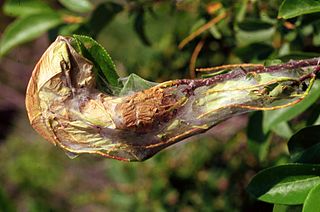
The Tortricidae are a family of moths, commonly known as tortrix moths or leafroller moths, in the order Lepidoptera. This large family has over 11,000 species described, and is the sole member of the superfamily Tortricoidea, although the genus Heliocosma is sometimes placed within this superfamily. Many of these are economically important pests. Olethreutidae is a junior synonym. The typical resting posture is with the wings folded back, producing a rather rounded profile.

Archips oporana, also known as the pine tortrix or spruce tortrix is a moth of the family Tortricidae, found in Asia and Europe. It was first described by Carl Linnaeus in 1758.

Archips podana, the large fruit-tree tortrix, is a moth of the family Tortricidae. The species was first described by Giovanni Antonio Scopoli in his 1763 Entomologia Carniolica. It is found in Europe, Asia from Anatolia to Japan and is an introduced species in North America.

Archips is a genus of tortrix moths the tribe Archipini. Species include the oak leaf roller, which eats the leaves of oak trees.

Archips semiferanus is a species of moth in the family Tortricidae, and one of several species of moth commonly known as oak leafroller or oak leaf roller. The larvae feed on the leaves of oak trees in the eastern United States and southeastern Canada and are a major defoliator of oak trees, which can lead to tree mortality. In Pennsylvania in the late 1960s and early 1970s, oak leafrollers defoliated over 1,045,000 acres (423,000 ha).

Archips betulana is a moth of the family Tortricidae. It is found from Fennoscandia south to Italy, Austria and Slovakia and from the Netherlands and Belgium east to southern Russia and the eastern part of the Palearctic realm.

Archips grisea, the gray archips moth or black shield leafroller, is a species of moth of the family Tortricidae. It is found in North America.

Archips crataegana, the brown oak tortrix, is a moth of the family Tortricidae. It is found in most of Europe east to Japan.

Archips cerasivorana, the ugly-nest caterpillar moth, is a species of moth of the family Tortricidae. The caterpillars of this species are known to create nests by tying the leaves of their host plant together. Within the nests, they live and feed off the leaves that have been tied together. The larvae are brownish or greenish yellow with a shiny dark brown head. Larvae can be found from May to July. The species overwinters as an egg, and pupation takes place within the nest. Caterpillars are seen follow one another in trails, a behavior prompted by the release of signaling pheromones from their spinnerets.
Archips asiaticus, the groundnut leafroller, is a species of moth of the family Tortricidae. It is found in Russia (Siberia), Korea, Japan and China.
Archips spinatus is a species of moth of the family Tortricidae. It is found in Liaoning, China.
Archips tharsaleopus is a species of moth of the family Tortricidae. It is found in Zhejiang and Yunnan, China.
Archips kellerianus is a species of moth of the family Tortricidae. It is found in Yunnan and Sichuan, China.
Archips myrrhophanes is a species of moth of the family Tortricidae. It is found in China and Taiwan.
Archips georgianus, the Georgia archips moth, is a species of moth of the family Tortricidae. It is found in North America, where it has been recorded from New Jersey, south to Florida and then west to Texas.
Archips dissitanus, the boldly-marked archips moth, is a species of moth of the family Tortricidae. It is found in North America, where it has been recorded from Alberta to Nova Scotia and south to Minnesota and North Carolina in the Appalachian Mountains. The habitat consists of boreal forests.
Archips packardianus, the spring spruce needle moth or spruce needleworm, is a species of moth of the family Tortricidae. Spruce needle worms are commonly found in small numbers on spruce and trees of other coniferous genera throughout most of Canada and the northeastern US. Archips packardiana overwinters as a tiny larva in a mined needle. Needle mining is resumed in the spring, the larvae later moving to feed on new foliage, where they spin considerable webbing. Full-grown larvae have a pale green head, sometimes patterned with brown, and a pale body and pale thoracic legs, and are about 20 mm long. The larva pupates, usually in the webbed needles, and the adult emerges in summer to early fall. The closely related Archips strianus is much less common, but probably has a habitat similar to that of A. packardiana. The larvae have dark thoracic legs and small dark areas around the base of the thoracic hairs. The habitat consists of coniferous and mixed woods.
Archips stellatus is a species of moth of the family Tortricidae that is endemic to Japan.
Archips limatus is a species of moth of the family Tortricidae. It is found in Shanxi, China.







